|
Revell's 1/72 scale Type VIIC
Project U-564 Part Three
by Frank Dargies
|
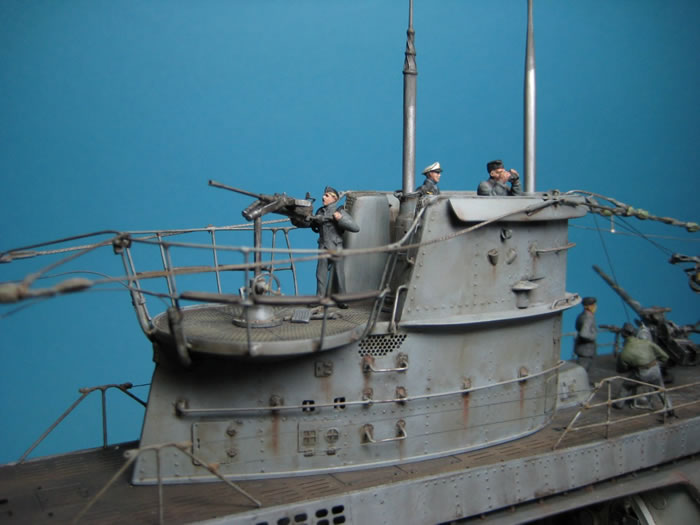
|
U-Boat Type VIIC
U-564 |

Revell's 1/72 scale U-Boat Type VIIC is available online from Squadron.com
 In March 2008 I started my project „U-564“, a VIIc U-boat under command by Kapitaenleutnant Reinhard „Teddy“ Suhren. In March 2008 I started my project „U-564“, a VIIc U-boat under command by Kapitaenleutnant Reinhard „Teddy“ Suhren.
I decided to build U-564 because I found ideal references in the book: “U-boat War Patrol: The Hidden Photographic Diary of U-564” (ISBN 1591148901)
In summer 1942 a war correspondent attended a war patrol of U-564 and took lots of photos of all areas of the Uboat. These photos were stored in a shoe box and discovered about 60 Years later in England. Lawrence Paterson collected and presented them in his book.
This is my most complex project, because I have used almost all the accessories available on the market .
The Interior
The following CMK sets were used:
Everything was supplemented by various parts and figures from the CMK sets:
All sections were supplemented by various scratchbuilt parts, for example:
The diesel control station including controls, instruments and engine telegraph.
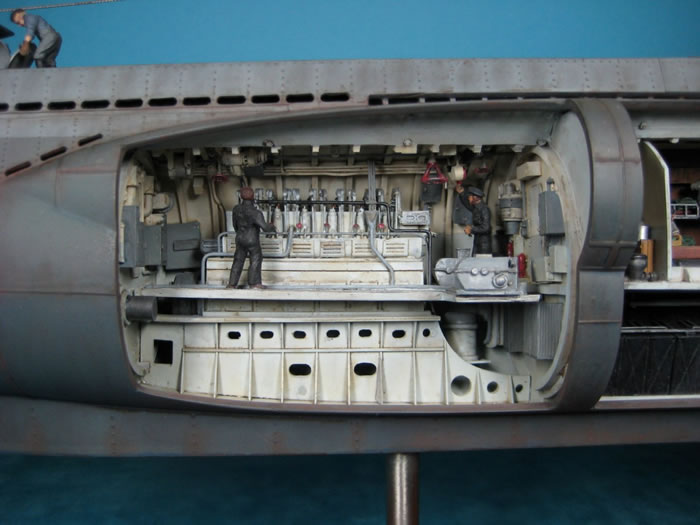
Pipelines and indicator valves were added to the diesel engine, sink and water taps were added to the Galley, the lavatory used as provision store was newly built, a table, alarm bell and open bulkhead were added to the officers ward room and the battery room was supplemented by bus bars and maintenance platform.
Command and torpedo section with additional valves, handwheels and tubes, handholds, compass, engine telegraphs, rudder angle indicator, speaking tubes, helmstand, nautical charts,
open torpedo tube, air and waterpipes, firing lever and torpedo loading device.
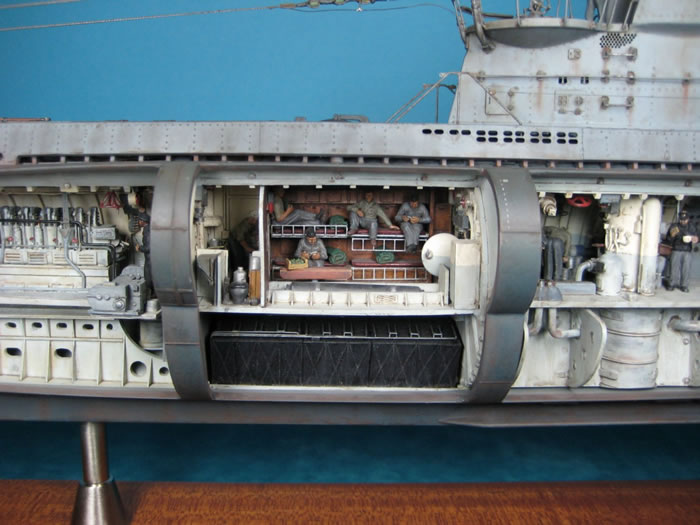
For all rooms, an illumination of 16V bulbs was installed.
These are supplied by a 9V battery, which gives a suitably subdued light.
Not missing of course, the crew at rest, the machine operators, command and torpedo room crew.
The following interior colors were used:
Interior above floor: RAL 9003 (Revell 5 matt white with 2% Humbrol 41 Ivory)
Interior below floor: RAL 9002 (Revell 5 matt white / Revell 69 gray granite 98% / 2%)
Interior other parts : RAL 7000 (Revell 57 dark grey)
Various ModelMaster Metalizer, Washing / Weathering with pastel chalks and artist oils in brown and black tones.

Engine room, officers and command section were glued into one complete unit.
The Hull
In advance I prepared the cut-outs in the starboard hull half. The halves and interior were fit together without glue at first, to make corrections. Here it had to be kept in mind that the visible part of the pressure hull (Upper Pressure Hull by Yankee Modelworks) would be installed later.
Many phases of construction are to plan ahead and you need to think very carefully before you stick something together!
Before the interior was glued in, I did all the work on the hull halves:
All upper flooding holes were opened, they partially had to be filled and redrilled.
The lower sections of the flooding holes were cut out of the hull and replaced with the correct detailed brass parts from the U-Brass Flood Kit.
The whole area of the torpedo doors was removed and rebuilt, the upper starboard torpedo door is shown openly.
The indicated doses of the sonar device were sanded off, drilled out and replaced with pieces of copper wire. The anchor bay was moved forward 7 mm, because its position was wrong (left as it was before, the anchor would have fallen onto the forward dive plane ...).
The inspection hatches of the saddle tanks (Model Brass Deck Set) were gently countersunk with a hot soldering iron and sanded over, various parts from the Eduard Photoetched Set were used.
All sanded rivets were pierced again by using a special tool.
Archer Transfers now supplies resin rivet heads , which are glued on a decal sheet in correct distance. I think, this would give a much more realistic effect.
Finally, the two hull halves were primed, some now visible gaps and errors were corrected and the halves were primed again then the interior sections were glued into the left fuselage half and finally both halves were glued together.
The Upper Pressure Hull
Next the pressure hull was adjusted. As provided for installation without interior sections, it had to be adapted completely, ground down to a thickness of about 3 mm (with a grinder, dust mask ... and do it outdoors !) and cut into separate pieces.
In addition, parts from the CMK Kit Winch For Loading Torpedoes and Rear Torpedoes Loading Hatch (by the way, the name is wrong, it is not at the aft torpedo loading hatch, but a pressure-proof deck tube) were fit into place. As a result of this, the exhaust system had to be rebuilt too.
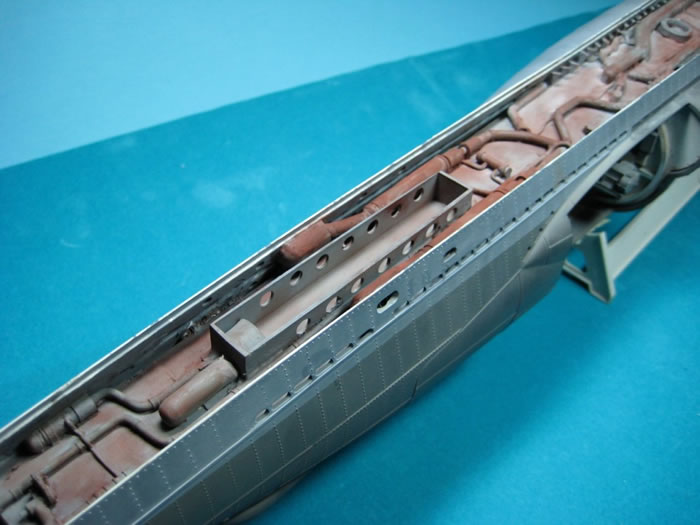
The attachment for the windlass has been redesigned and equipped with a chain.
The lower part of the conning tower pressure hull was missing and therefore rebuilt.
After assembling the individual parts of the upper pressure hull, 89 bars were made from plastic sheet
and glued in, because the long horizontal flood hole was previously opened, so the bars are now visible from outside.
The Deck
Time for the installation of the deck (Model Brass Deck Set).
The three deck parts fit pretty well, but the entire deck had to be underlined with plastic strips, otherwise it would have been too low.
To begin at the bow: Here I inserted a brass tube, to represent the “bull nose” for the tow hook.
The cut-outs for the front torpedo loading hatch and the aft torpedo deck tube had to be done
before installing the three deck sections on the hull, even during installation of the upper pressure hull they had to be accurately measured and adjusted.
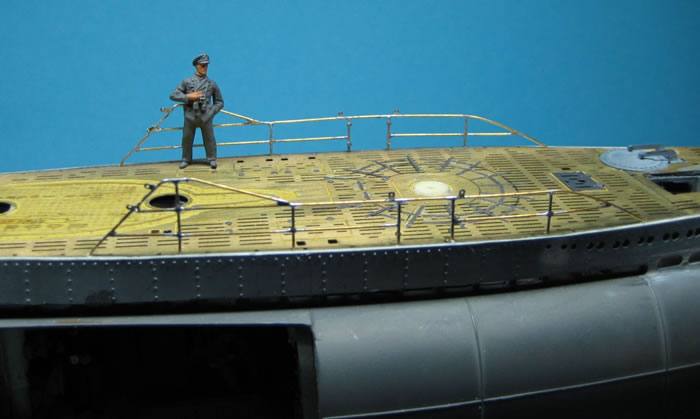
The hatches of the pressure-resistant container for the “Marcks” life rafts have been completely
redesigned and provided with the hinge-arms from the Eduard Photo Etched Set.
All deck covers, hinges, the anti slip strips around the 8.8 gun and the capstan are also taken from this set.
The aft tripod supports for the antenna wires were built new, because the Revell parts were too high, as well as the railings and the two boat hooks. All parts were made of 0.6 mm brass wire.
After installation of the deck, the hull was painted:
Hull Top: RAL 7000 = Revell 57
Hull bottom: RAL 7016 = Revell 77
Upper deck: Mix of "Vallejo Model Color" Black-Grey 862, 984 Matt Brown, 913 Ochre
The Wooden decks of the original boats were painted with a black wood preservative “Teerfirnis TF99” or Carbolineum”, the iron deck parts were black.
But because of weathering the black wood preservative became a brighter gray-brown, especially at the deck areas, which were entered more frequently by the crew.
After painting, the AMP Waterline Decals were applied. Then the hull was filtered, washed and weathered by artist oils, pastel chalk and pigments. Finally, everything was sealed with matt varnish.
Two brass propellers from Raboesch were used. They were brought into the right shape and weathered. Therefore I placed them in a salt / vinegar mixture for a few days to produce a slight corrosion.
The 8.8 Deck Gun
The deck gun is a mix of Revell, CMK and Eduard parts.
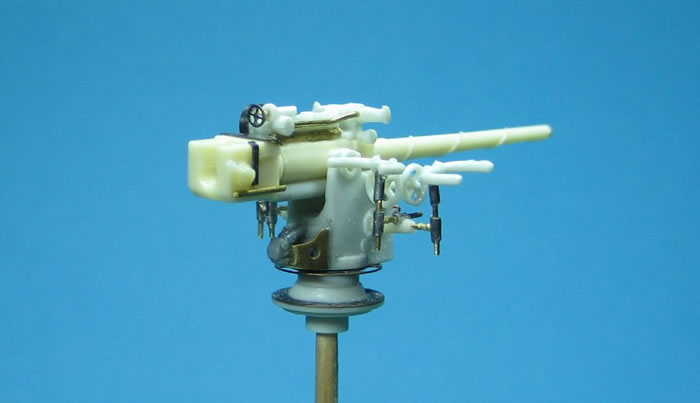
The gun carriage from the Revell kit was used.This time the CMK part (Exterior Set Part 1 - Turret) was much worse. The gun barrel was taken from CMK. All other parts were scratch-built.
(Work load for the gun with prior research took about 10 hours…)
The Conning Tower
First of all, an inner pressure hull and some air vents for the inner side of the conning tower were built, because they will later be visible through the deck.
From the Revell Kit I took only the lower and upper conning tower halves, the rest is unfortunately inadequate and primitive detailed, so I didn’t use these parts.
The tower halves were completely revised, all doors sanded off and replaced by Eduard and U-Brass Photo Etched parts.
Various openings were created, railing and steps were made from brass wire.
The entire area of the stern light, and the stern light itself were redesigned, the insulators for antenna wires added, and the conning tower deck replaced with the Model Brass part.
The eyelets round the rear conning tower deck (called "Wintergarten"), are designed for the Revell railing, which is much too thick. So they were sanded off and an outline from plastic sheet was placed around the deck. You will not find these eyelets on an original boat by the way…
A wooden template was made, and a new railing from 0.6 mm brass wire was soldered.
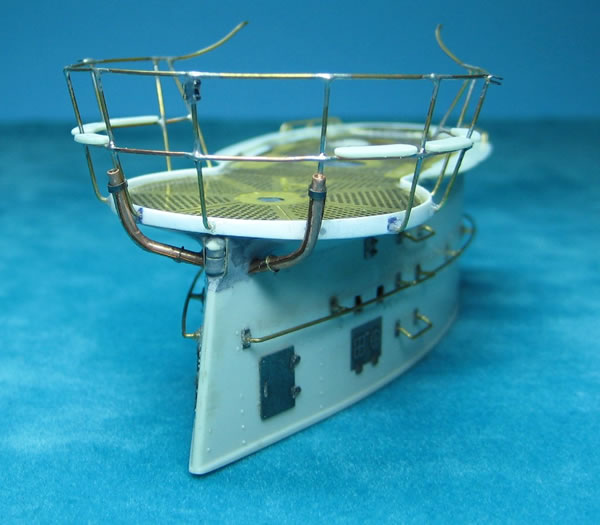
After adding some additional details to the conning tower deck area, tower and deck were painted.
The two top part walls were sanded from the inside, the upper edges and rigging clamps corrected and holes with arresting eyelets for the bridge crew added.
The housing for the loop antenna was extended downward, wood paneling, folding seats, running boards, grilles for Diesel air intakes, a voice tube, rudder indicator and compass were mounted.
Outside the walls, the brackets for life rings, the wind deflector and railings from brass wire were brought in place.
The navigation lights were made from clear plastic and the holes for front antenna insulator and typhoons were redesigned.
After painting the top parts, the ULAD Decal "Three Times Black Cat", (an old German magic spell) was set.
The housing for the observation scope was scratchbuilt; neither Revell nor CMK parts were designed correctly.
UZO (U-boat target visor) pillar, main hatch, attack periscope housing and 2cm flak gun were built scratch and supplemented by various Eduard and CMK parts, the gun barrel was taken from Schatton.

For the observation scope itself, the Revell part was chosen, the attack scope was taken from the
CMK (Exterior Set Part1 - Turret) and was supplemented with 0.1 mm copper wire twisted around to simulate "steel cables” that reduced the water turbulence and vibrations during periscope operation.
Thus, the conning tower was completed and the whole construction was mounted on the hull.
Completion
At last, the torpedo-loading tray from the CMK Winch For Loading Torpedoes set was assembled and a Schatton brass torpedo installed.
A difficult task was the rigging, this time the supplied blocks / insulators from Revell were not too large, but too small ... and not constructed like the original. Again the only solution was to build them from scratch
The blocks were handmade from wood (20 pieces), the line tensioners (11 pieces) were included in the U-Brass Set. Everything was rigged with 0.6 mm Dacron cord.
Finally, the boat was supplemented by the deck crew figures from CMK and Hecker&Goros.
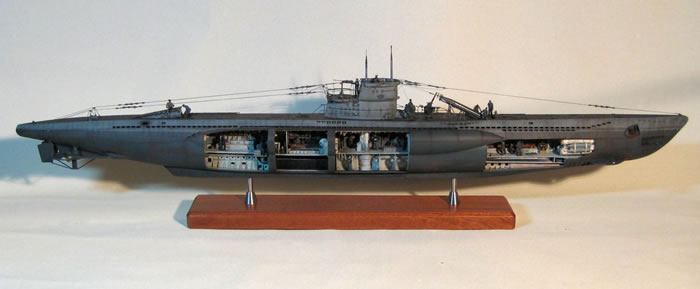
Now, in July 2011 the project U 564 is finished after a construction time of three years and four months.
U-564 Data
U-564
Type VIIC
Field post Number M 40 175
Construction Yard Blohm und Voß, Hamburg
Yard Number 540
Ordered 24th Oct 1939
Keel laid 30th Mar 1940
Launched 7th Feb 1941
Commissioned 3rd Apr 1941
Commanders
03.04.1941 - 01.10.1942 Oblt.z.S./Kptlt./Korv.Kpt./ Reinhard Suhren
(Later Freg.Kpt / FdU Nordmeer)
01.10.1942 - 14.06.1943 Oblt.z.S. Hans Fiedler
Flotillas
03.04.1941 - 06.1941 Ausbildungsboot (under training) 1. U-Flottille, Kiel
06.1941 - 14.06.1943 Frontboot (operational) 1. U-Flottille, Brest
Operations
Number of Operations: 9
Sunk Ships: 19
Sunk Tonnage: 96.444 BRT
Damaged Ships: 5
Damaged Tonnage: 31.036 BRT
U 564 was sunk on 14.06.1943 in the Biscay under the command of Oblt.z.S. Hans Fiedler northwest Cape Ortegal under attack by depth charges of a Whitley G from British Operational Training Unit Squadron 10.
References:
Lawrence Paterson „U 564 auf Feindfahrt – 70 Tage an Bord“ ISBN 3-613-02528-0
Fritz Brustat-Naval / Teddy Suhren „Nasses Eichenlaub“ ISBN 3-7822-0734-3
Köhl/Niestle „Uboottyp VIIc Vom Original zum Modell“ ISBN 3-7637-6002-4
More pictures, information and the progress of this project may be found on my website http://www.dargies.de
Model, Images and Text Copyright ©
2009 by Frank Dargies
Page Created 14 October, 2011
Last Updated
14 October, 2011
Back to
HyperScale Main Page

|
Home
| What's New |
Features |
Gallery |
Reviews |
Reference |
Forum |
Search